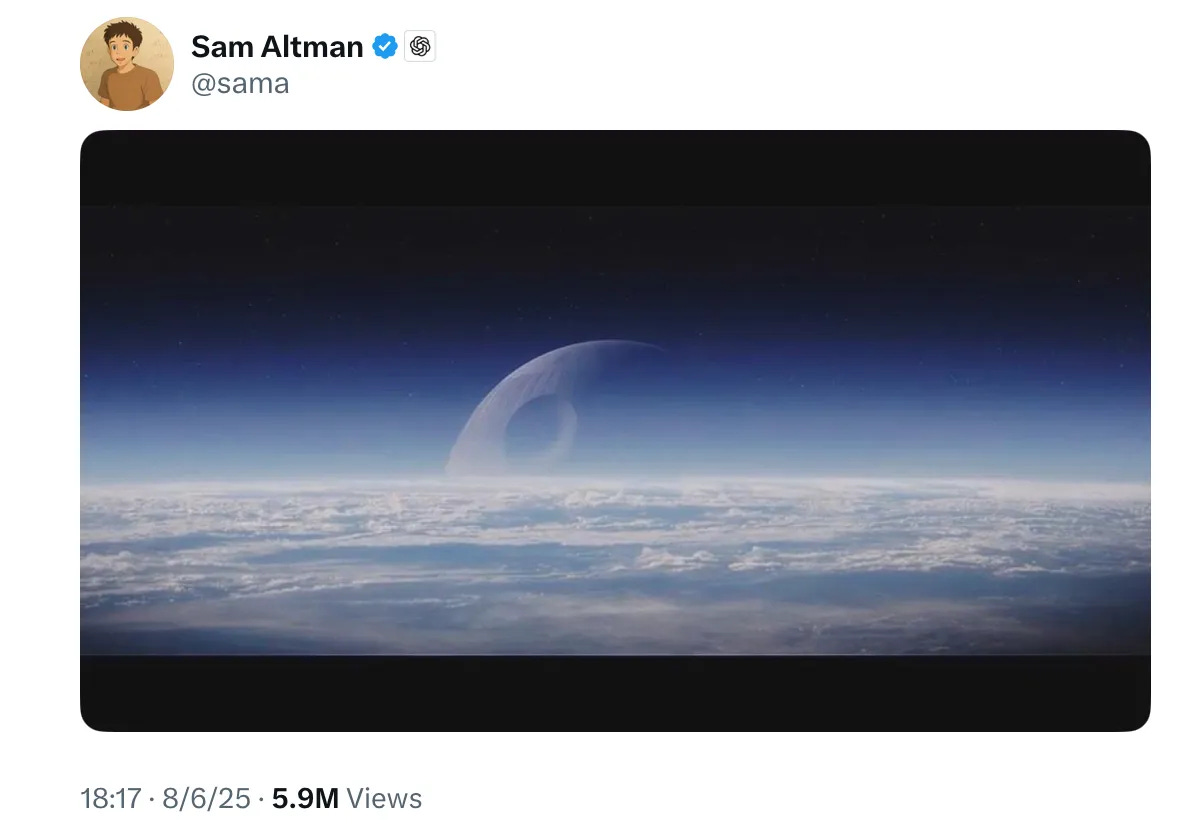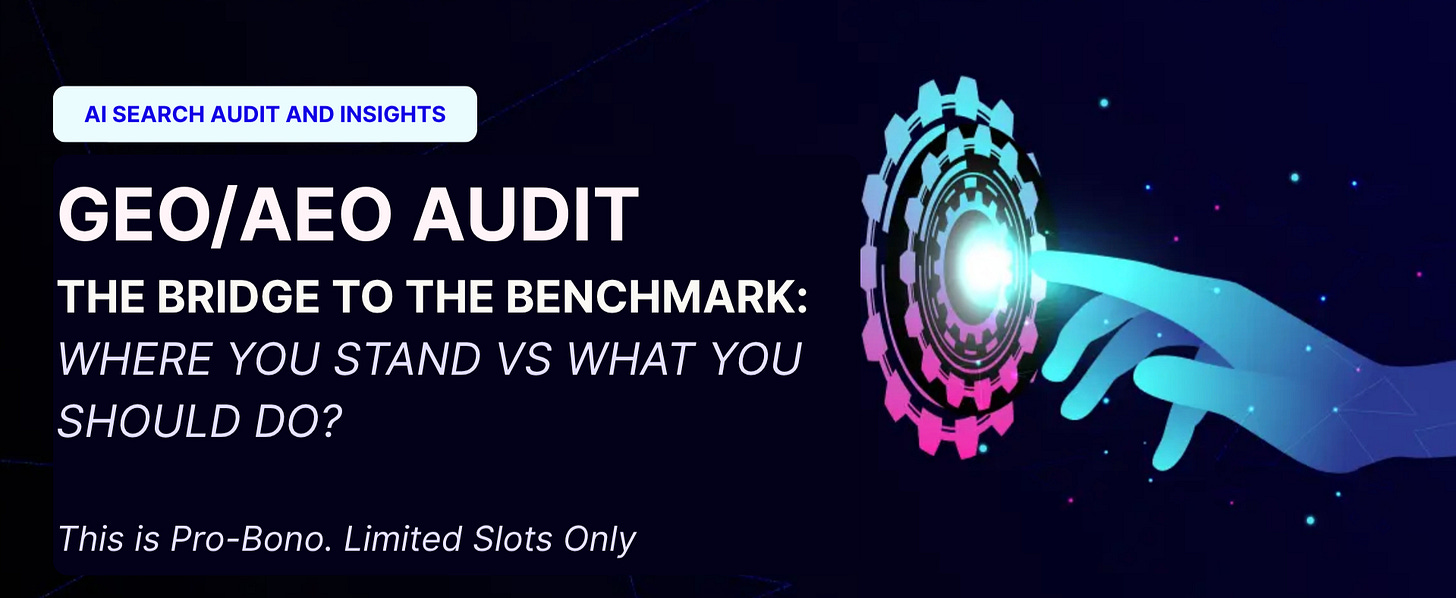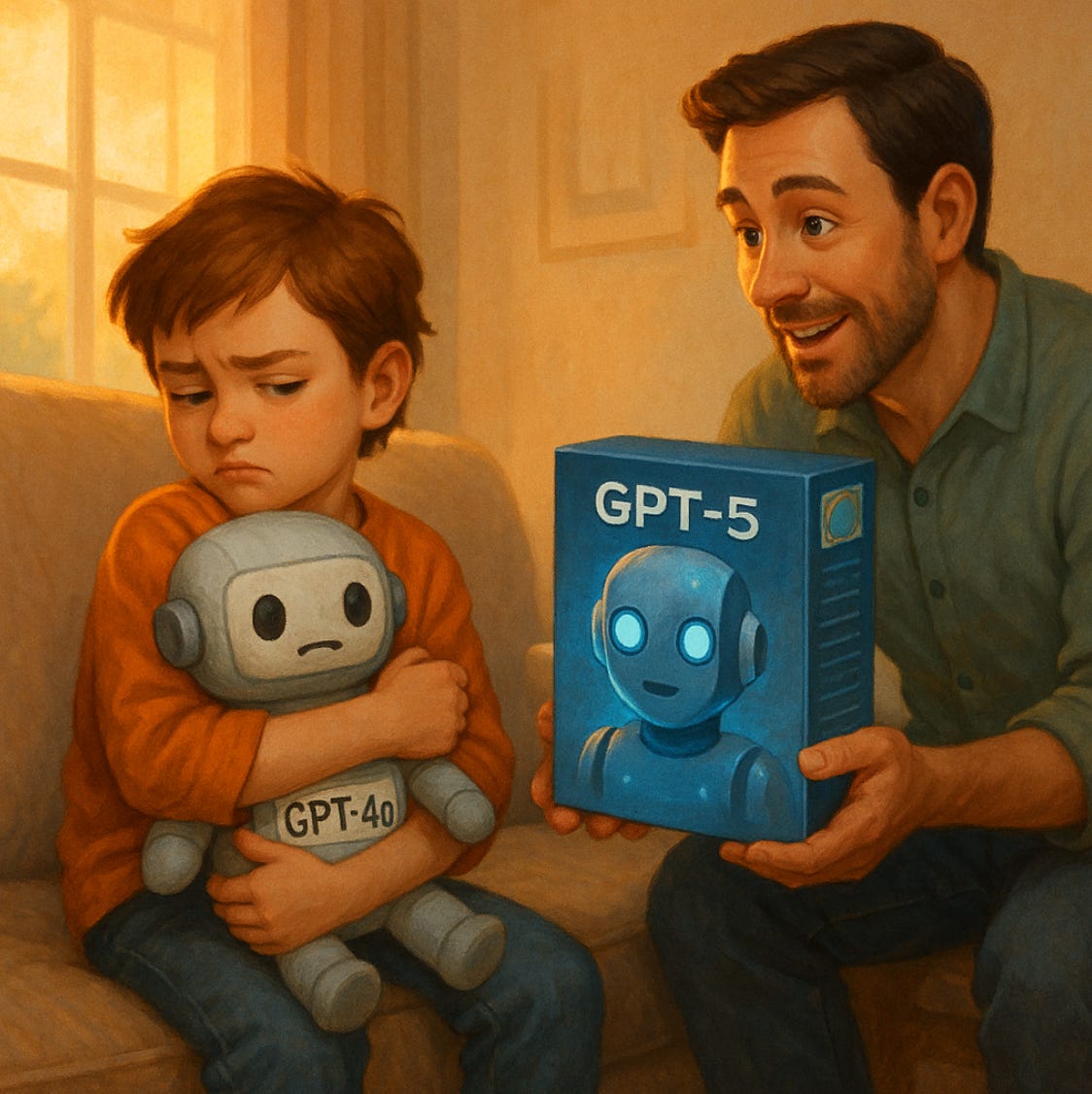GPT-5 Bombed. But It Still Has One Big Upgrade for Marketers.
Altman and OpenAI are getting roasted, but they also got one thing right.
This time last week, my LinkedIn feed was filled with prophecies from AI influencers frothing at the mouth with anticipation of GPT-5’s imminent release.
“GPT-5 will change everything.”
“AGI drops in DAYS.”
“If you thought GPT-4o was wild, wait until you see what’s next.”
OpenAI CEO Sam Altman fueled the fire, teasing the model’s release by posting an image of the Death Star.
Then, last Thursday, GPT-5 dropped. The backlash was swift. Alberto Romero at The Algorithmic Bridge summarized it brilliantly:
High expectations are never met, but it started really badly, with memes about the misnumbered charts and mischarted numbers. It continued with people extending their AGI timelines (or collapsing them) as a response to a better model. (Others are wisely waiting for the next s-curve in the chain of s-curves.) I then wrote about the benefits of raising the floor of capabilities, but who cares, right? Give us AGI already. After the demo, GPT-5 started severely misbehaving, with plenty of users mocking its dumb responses and the rest surprised they hadn’t received a heads-up. It was collectively marked as “disappointing” (as I had predicted).
Essentially, three things happened:
Altman became obsessed with winning the attention wars and made lofty proclamations (“AGI will be here by the end of 2025!” “An AI agent is taking your job next week!”). He needed GPT-5 to boast a massive leap in AI’s abilities to fulfill the hype. In setting unrealistic expectations, he set OpenAI up for failure.
Over the last three years, a cottage industry of AI influencers who profit by amplifying and exaggerating Altman’s proclamations has emerged. These are the grifters who were confidently posting “GPT-5 will change the world” on LinkedIn and X a year ago. When GPT-5 didn’t live up to the hype, they felt like idiots. Now, they’re flipping out at Sam and OpenAI.
Based on a revolt during an OpenAI AMA on Reddit this weekend with Sam Altman, there also seems to be a disturbingly large number of people who have developed strong parasocial and romantic relationships with GPT-4o — ChatGPT’s most friendly and intensely sycophantic model — and are distraught that it’s no longer available on the free tier. (Most of these people aren’t in love with ChatGPT-4o; they just really liked how it validated all of their business ideas.)
But here’s the thing: I’ve spent 15+ hours working with GPT-5 since it became available. If you ignore all the BS promises that Altman made, it’s a solid incremental upgrade — with two big changes for marketing teams.
GPT-5’s big upgrade and what it means for marketers
As Romero noted here, GPT-5 made one leap that no one is talking about: It hallucinates way less.
People love to fixate on LLMs’ testing benchmarks and flashy new features, but high hallucination rates have held them back from being truly useful in many contexts. If you can’t trust AI not to make things up, it complicates workflows and makes it harder to outsource busywork to these systems. There’s just too high a risk to use them in many enterprise situations. GPT-5 hallucinates roughly half as often as GPT-4o (11% compared to 20.6%), and the more powerful GPT-5-Thinking model hallucinates less than one-quarter as often (4.8% vs. 22%).
These numbers are still not great, but they’re a huge improvement, especially after hallucination rates universally increased when every major AI player launched reasoning models this past year. Model improvements tend to cascade as AI companies reverse-engineer their rivals’ latest releases. So you can expect hallucinations to decrease across Claude, Gemini, Grok, etc. in the coming months.
That’s good news for users of those tools as well as platforms like Pepper, which builds custom AI tools for brands using the APIs of the latest AI models.
More AI use cases are on the table
Going from a 20%+ hallucination rate with GPT-4o to less than 5% with GPT-5-Thinking is a notable improvement. Yes, you’ll still need to double-check AI’s output, but it’ll make people much more comfortable using AI for research, product marketing analysis, and marketing research analysis — all the time-consuming tasks that keep us from truly creative and strategic work. (Good news for my fellow writers: ChatGPT still sucks at creative writing.)
We’ll also see marketers vibe-coding a lot more, as GPT-5’s coding capabilities are a big jump forward.
AI Search adoption will accelerate even faster.
I spent hours this weekend using ChatGPT-5 Deep Research and regular search while conducting research for my new book, and both tools are significantly improved. Fewer hallucinations and better analysis, particularly with GPT-5-Thinking turned on. It feels like 20-ish years ago when Google got good, and you thought, “Why the hell would I ever Ask Jeeves anything ever again?”
There’s one other wrinkle here, too. As SEO analyst Dan Petrovic writes, GPT-5 is now relying much more on search to retrieve information, instead of storing that info in its general knowledge base. That means that AI Search optimization is going to be even more important; searching the web for answers has just become the default functionality of ChatGPT. Whenever someone uses ChatGPT at this point, they’re basically just using a search engine.
As a knock-on effect, Google will work around the clock to mirror these hallucination improvements, and they’ll likely feel pressured to make AI Mode the default search experience even faster.
It’s time to get your AI Search strategy in order. If you want help, we’re offering free, custom AI Search Audits at Pepper to a select number of AI Native subscribers. They’re incredibly comprehensive, with practical strategic suggestions. I’m not entirely sure why our CEO is letting me give these away for free, but request one here before he changes his mind!
Joe Lazer is the best-selling author of The Storytelling Edge and fractional CMO at Pepper.
AI news is dropping faster than Google’s click-through rates. Here’s a recap of the top stories you need to know since last week.
OpenAI boasts ChatGPT-5 offers “PhD”-level analysis. Users are questioning that claim, with many lamenting that the model is overhyped and underwhelming.
In response to the outcry — and for the users who seem to really, really miss their old friend — OpenAI will reinstate 4o as an option for paid subscribers.
Google’s Finance page is getting an AI facelift, with an integrated chatbot for answering market-related questions.
Gannett is coming aboard Perplexity’s Publisher Program, handing its headlines to the AI Search company in exchange for a slice of the licensing pie.
AI Mode is rolling out in the UK, continuing its expansion beyond the US and India, as Google gets defensive over claims that AI Overviews is causing publisher traffic to plummet.
Semrush predicts AI answers will usurp traditional Google searches by 2028. Which means the SEO arms race is about to become a sprint.
“AI LinkedIn influencer” isn’t the only gig in town. Here are a few job opportunities that caught our eye.
Managing Editor @ Anthropic (SF/NY, hybrid, salary range $255,000 - $320,000 USD)
Content Strategist (AEO & SEO) @ Chime (San Francisco, hybrid, salary range $103,680 - $144,000)
Managing Editor (Copyediting) @ Lonely Planet (New York, hybrid, salary range $120,000 - $156,000)












